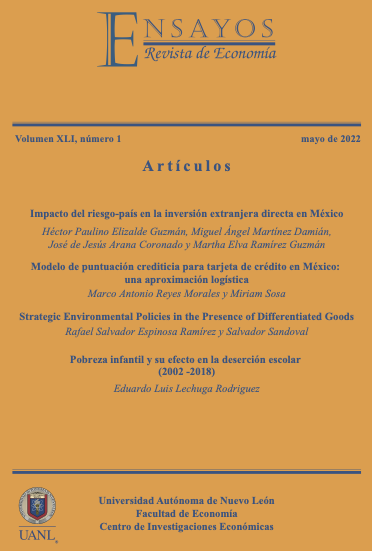Strategic Environmental Policies in the Presence of Differentiated Goods
Políticas ambientales estratégicas en presencia de bienes diferenciados
DOI:
https://doi.org/10.29105/ensayos41.1-3Palabras clave:
Strategic environmental policy, pollution quota, pollution disutility, oligopolistic competition, welfareResumen
We develop a theoretical model of partial equilibrium where firms, located in a country, compete and produce differentiated goods in a duopolistic market. Emission of pollution is related to production, and firms produce their output using different levels of polluting technology. To control pollution emission, the government applies discriminatory pollution quotas considering the benefits for firms, consumers, and environmental damage. The results show that if the disutility to be polluted is very high, the government imposes a zero-emission quota on the companies. But, if such disutility is not significantly high, it allows a certain amount of emissions, imposing different quotas on firms depending on the levels of technology they use to control their emissions. The proposed model stresses the importance of the rational establishment of strategic environmental policies, which benefit all economic agents in the market, firms, consumers, and the environment.
Resumen
Desarrollamos un modelo teórico de equilibrio parcial donde las empresas, ubicadas en un país, compiten y producen bienes diferenciados en un mercado duopolístico. La emisión de contaminación está relacionada con la producción, y las empresas producen utilizando diferentes niveles de tecnología contaminante. Para controlar la emisión de contaminación, el gobierno aplica cuotas de contaminación discriminatorias teniendo en cuenta el beneficio para las empresas, los consumidores y el daño ambiental. Los resultados muestran que si la desutilidad a contaminar es muy alta, el gobierno impone una cuota de cero emisiones a las empresas. Pero, si dicha desutilidad no es significativamente alta, permite una cierta cantidad de emisiones, imponiendo diferentes cuotas a las empresas dependiendo de los niveles de tecnología que utilizan para controlar sus emisiones. El modelo propuesto subraya la importancia del establecimiento racional de políticas ambientales estratégicas, que actúen en beneficio de todos los agentes económicos en el mercado, las empresas, los consumidores y el medio ambiente.Descargas
Citas
Arguedas, C. and Rousseau, S. (2021). Energy-efficient design, consumer awareness, and public policy. SERIEs 12, 231–254. https://doi.org/10.1007/s13209-020-00225-1 DOI: https://doi.org/10.1007/s13209-020-00225-1
Bayindir-Upmann, T. (2000). Do Monopolies Justifiably Fear Environmental Tax Reforms? Finanzarchiv, 57(4), 459-484. https://www.jstor.org/stable/40912942 DOI: https://doi.org/10.1628/0015221012904832
Chartand, T. (2005). The role of conscious awareness in consumer behaviour. Journal of Consumer Psychology, 3 (15), 203–210. https://10.1207/s15327663jcp1503_4 DOI: https://doi.org/10.1207/s15327663jcp1503_4
Cropper, M.L. and Oates, W.E. (1992). Environmental economics: a survey. Journal of Economic Literature, 30(2), 675–740.
Deng, Q. (2021) Foreign direct investment and discriminatory environmental enforcement: a firm level perspective. Environmental Politics, 30(6), 958-980. https://doi.org/10.1080/09644016.2020.1817257 DOI: https://doi.org/10.1080/09644016.2020.1817257
Endres, A. and Rundshagen, B. (2013). Incentives to diffuse advanced abatement technology agreements. Environmental and Resource Economics, 56(1), 177–210. https://doi.org/10.1007/s10640-012-9596-9 DOI: https://doi.org/10.1007/s10640-012-9596-9
Erdogan, A.M. (2013). Foreign direct investment and environmental regulations: a survey. Journal of Economic Surveys, 28 (5), 943–955. https://doi.org/10.1111/joes.12047 DOI: https://doi.org/10.1111/joes.12047
Espínola-Arredondo, A. and Zhao, H. (2012). Environmental policy in a linear city model of product differentiation. Environment and Development Economics, 17(4), 461-477. https://doi.org/10.1017/S1355770X12000071 DOI: https://doi.org/10.1017/S1355770X12000071
European Union (2015). Diario Oficial de la Unión Europea (28/11/2015). https://eur-lex.europa.eu/legal-content/ES/TXT/PDF/?uri=OJ:L:2015:313:FULL&from=ES. Accessed 15 October 2021
Field, B.C. and Field, M.K. (2003). Economía del Medio Ambiente (3rd ed.). Madrid: Ed. McGraw Hill.
Fujiwara, K. (2009). Environmental policies in a differentiated oligopoly revisited. Resource and Energy Economics, 31(3), 239-247. https://doi.org/10.1016/j.reseneeco.2009.03.002 DOI: https://doi.org/10.1016/j.reseneeco.2009.03.002
Fullerton, D. and Metcalf G.E. (2002). Cap and Trade Policies in the Presence of Monopoly and Distortionary Taxation. NBEW-Working. https://www.nber.org/system/files/working_papers/w8901/w8901.pdf DOI: https://doi.org/10.3386/w8901
Gautier, L. (2015). Horizontal product differentiation and policy adjustment in the presence of abatement subsidies and emission taxes. Journal of Environmental Economics and Policy, 4(1), 64-81. https://doi.org/10.1080/21606544.2014.972467 DOI: https://doi.org/10.1080/21606544.2014.972467
Golombek, R. and Hoel, M. (2006). Second-best climate agreements and technology policy. Advances in Economic Analysis & Policy, 6(1), 1–28. https://doi.org/https://doi.org/10.2202/1538-0637.1472 DOI: https://doi.org/10.2202/1538-0637.1472
Golombek, R. and Hoel, M. (2008). Endogenous technology and tradable emission quotas. Resource and Energy Economics, 30(2), 197–208. https://doi.org/10.1016/j.reseneeco.2007.08.003 DOI: https://doi.org/10.1016/j.reseneeco.2007.08.003
Hussen, A. (2018). Principles of environmental economics and sustainability (4th ed.). New York: Routledge. DOI: https://doi.org/10.4324/9781351109116
Kayalica, M.Ö. and Lahiri, S. (2005). Strategic environmental policies in the presence of foreign direct investment. Environmental and Resource Economics, 30(1), 1-21. https://doi.org/10.1007/s10640-004-0757-3 DOI: https://doi.org/10.1007/s10640-004-0757-3
Kollmuss, A. and Agyeman, J. (2002). Mind the gap: why do people act environmentally and what are the barriers to pro-environmental behavior?. Environmental Education Research, 8 (3), 239–260. https://10.1080/13504620220145401 DOI: https://doi.org/10.1080/13504620220145401
Kolstad, C. (2011). Intermediate environmental economics (2nd ed.). Oxford University Press.
Lahiri, S. and Ono, Y. (2000). Protecting environment in the presence of foreign direct investment: tax versus quantity restriction. Economics Discussion Papers 9985, University of Essex.
Martínez-Alier, J. and Roca-Justmen, J. (2000) Economía ecológica y política ambiental. México, Fondo de Cultura Económica.
Montero, J.P. (2002). Permits, Standards, and Technology Innovation. Journal of Environmental Economics and Management, 44(1), 23-44. https://doi.org/10.1006/jeem.2001.1194 DOI: https://doi.org/10.1006/jeem.2001.1194
Moraga-González, J.L. and Padrón-Fumero, N. (2002). Environmental Policy in a Green Market. Environmental and Resource Economics, 22(3), 419-447. https://doi.org/10.1023/A:1016060928997 DOI: https://doi.org/10.1023/A:1016060928997
Requate, T. (2005). Environmental Policy under Imperfect Competition: A Survey. Economics Working Paper, No. 2005-12, Kiel University, Department of Economics, Kiel. https://www.econstor.eu/bitstream/10419/22000/1/EWP-2005-12.pdf
Sandoval, S. and Espinosa, R.S. (2020). Cuotas de contaminación y tecnología medioambiental diferenciada en presencia de inversión extranjera directa. Contaduría y Administración, 66(2), 1–18. https://doi.org/http://dx.doi.org/10.22201/fca.24488410e.2021.2645 DOI: https://doi.org/10.22201/fca.24488410e.2021.2645
Siegel, L., Cutter-Mackenzie-Knowles, A. & Bellert, A. (2018). Still ‘minding the gap’ sixteen years later: (re)storying pro-environmental behaviour. Australian Journal of Environmental Education, 34 (2), 189–203. https://10.1017/aee.2018.32 DOI: https://doi.org/10.1017/aee.2018.32
Stimming, M. (1999). Capital accumulation games under environmental regulation and duopolistic competition. Journal of Economics, 69, 267-287. https://doi.org/10.1007/BF01231162 DOI: https://doi.org/10.1007/BF01231162
UNEP (2019). Programme performance report 2018. Resource Document. UN Environment Programme. https://wedocs.unep.org/bitstream/handle/20.500.11822/27734/PPR_2018_FINAL.pdf. Accessed 20 June 2019
Descargas
Publicado
Cómo citar
Número
Sección
Licencia
Derechos de autor 2021 Rafael Salvador Espinosa Ramírez, Salvador Sandoval

Esta obra está bajo una licencia internacional Creative Commons Atribución 4.0.
















